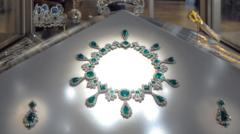Can France Reclaim Its Priceless Crown Jewels?

Published: 2025-10-21 04:00:28 | Category: technology
The recent robbery at the Louvre has left experts concerned about the fate of priceless jewels stolen in a daylight heist. The thieves executed their plan with alarming efficiency, stealing eight valuable items in just eight minutes. With fears that the jewels may already be broken up and sold for a fraction of their worth, the chances of recovery seem bleak.
Last updated: 16 October 2023 (BST)
Key Takeaways
- The Louvre was robbed of eight priceless jewels in a quick, professional heist.
- Experts believe the stolen items may be dismantled and sold for much less than their original value.
- A specialist police unit is investigating, suspecting links to organised crime.
- Potential value of the stolen gems and gold could reach up to £10 million.
- The emotional impact of the theft resonates deeply with the French public.
The Heist: How It Unfolded
On a seemingly ordinary Sunday, thieves executed a meticulously planned robbery at the Louvre, the world's most-visited museum. Within eight minutes, they managed to steal eight items, showcasing both their preparation and audacity. As they sped away on scooters, the operation's speed suggested a level of professionalism rarely seen in such crimes.
Expert Opinions on the Robbery
Arthur Brand, a Dutch art detective, estimated that due to the nature of the heist, the jewels might already be "long gone." He indicated that the thieves likely belong to a professional gang with prior experience in similar crimes. Their ability to execute the robbery so swiftly pointed to extensive planning and knowledge of the museum's layout.
Organised Crime Links
French authorities suspect that the robbery is linked to an organised crime network. According to Paris prosecutor Laure Beccuau, such groups often have two primary objectives: either to benefit a sponsor or to obtain precious gems for money laundering. This connection suggests the perpetrators are not amateur criminals but part of a larger, more dangerous operation.
The Aftermath: What Happens Next?
As the investigation unfolds, experts have expressed concerns that the stolen jewels could be dismantled and sold piece by piece. Brand believes that selling the items intact would be nearly impossible, as they are "too hot to handle." Instead, he suggests that the gold and silver will likely be melted down, and the gems cut into smaller stones, making them virtually untraceable.
The Value of What Was Stolen
The potential financial loss from this heist is staggering. Tobias Kormind, managing director of 77 Diamonds, stated that the total value of the stolen items could reach £10 million. The larger stones could each fetch around £500,000, indicating a significant financial hit for the art world and the French heritage sector.
Comparing the Heist to Historical Precedents
Interestingly, there are instances in history where stolen jewellery has re-emerged years later. The Cartier exhibition at the V&A Museum featured an item stolen in 1948 that reappeared at auction decades later. However, as days pass since the robbery, hope for the recovery of the intact jewels diminishes.
The Emotional Impact on France
The theft has not only financial implications but emotional ones as well. Many in France feel a deep emotional attachment to the stolen jewels, viewing them as part of the nation's cultural heritage. Alexandre Leger, head of heritage at French jeweller Maison Vever, expressed the sentiment that the jewels belong to all of France, much like the Mona Lisa. This robbery feels personal, as if a piece of the nation has been stolen.
The Role of the Police
In response to this brazen theft, a specialist police unit renowned for its success in solving high-profile robberies has been assigned to the case. Their experience and focus on organised crime will be crucial in tracking down the perpetrators and potentially recovering the stolen items.
Future Implications
The implications of this heist extend beyond immediate financial loss. It raises concerns about security measures in place at other cultural institutions and whether they are sufficient to deter similar crimes. As art theft continues to evolve, so too must the strategies employed to protect invaluable cultural heritage.
Conclusion: A Call for Vigilance
The theft of these jewels from the Louvre serves as a stark reminder of the vulnerabilities faced by cultural institutions. As experts continue to analyse the situation, it is clear that vigilance and enhanced security protocols are essential to prevent future incidents. The emotional weight of this robbery lingers, leaving many to ponder the fate of the stolen treasures.
FAQs
What items were stolen from the Louvre during the robbery?
The thieves stole eight items, including valuable gemstones and a crown from Empress Eugénie, which are considered priceless.
How much are the stolen jewels potentially worth?
Experts estimate the stolen gems and gold could be worth up to £10 million, with larger stones alone potentially fetching around £500,000 each.
What is the connection between the robbery and organised crime?
Authorities suspect the robbery is linked to an organised crime network, which often engages in similar high-profile thefts and money laundering operations.
Are there any chances of recovering the stolen jewels?
While there is a slim chance that the jewels could appear intact, experts believe they are likely to be dismantled and sold for much less than their original value, diminishing recovery hopes.
What steps are being taken to investigate the robbery?
A specialist police unit known for successfully solving high-profile robberies has been assigned to investigate the incident and track down the perpetrators.
As the investigation into the Louvre heist continues, the call for enhanced security measures and public awareness will be more crucial than ever. The emotional and cultural significance of the stolen items resonates deeply within France, prompting a collective sentiment of loss. #LouvreHeist #ArtTheft #CulturalHeritage



